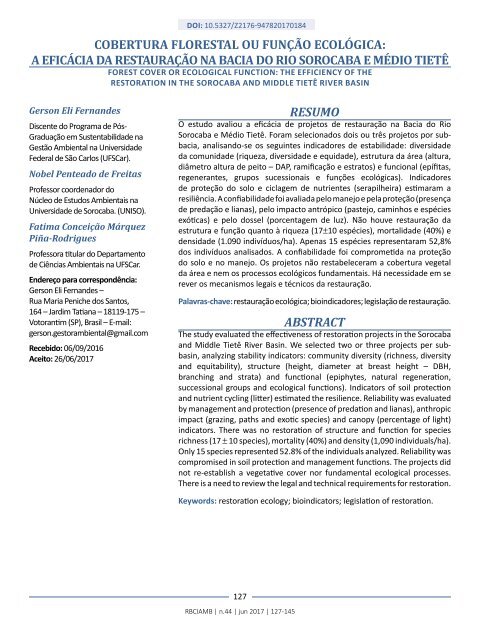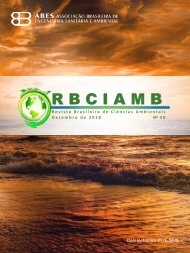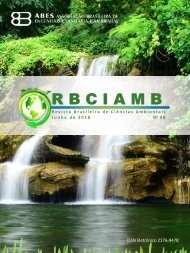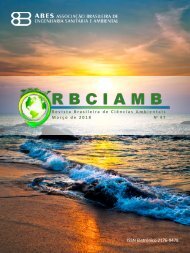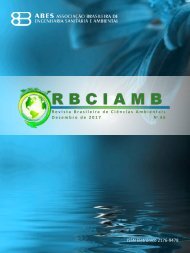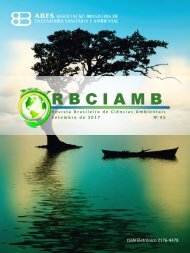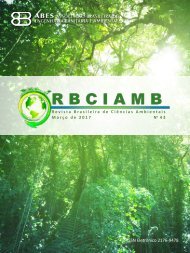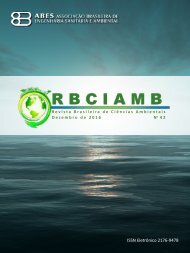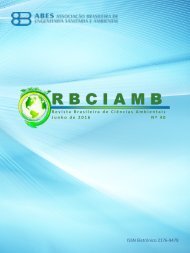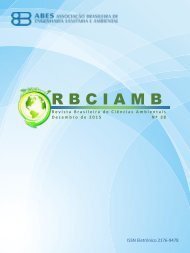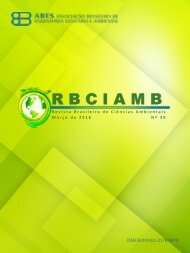You also want an ePaper? Increase the reach of your titles
YUMPU automatically turns print PDFs into web optimized ePapers that Google loves.
DOI: 10.5327/Z2176-947820170184<br />
COBERTURA FLORESTAL OU FUNÇÃO ECOLÓGICA:<br />
A EFICÁCIA DA RESTAURAÇÃO NA BACIA DO RIO SOROCABA E MÉDIO TIETÊ<br />
FOREST COVER OR ECOLOGICAL FUNCTION: THE EFFICIENCY OF THE<br />
RESTORATION IN THE SOROCABA AND MIDDLE TIETÊ RIVER BASIN<br />
Gerson Eli Fernandes<br />
Discente do Programa de Pós-<br />
Graduação em Sustentabilidade na<br />
Gestão Ambiental na Universidade<br />
Federal de São Carlos (UFSCar).<br />
Nobel Penteado de Freitas<br />
Professor coordenador do<br />
Núcleo de Estudos Ambientais na<br />
Universidade de Sorocaba. (UNISO).<br />
Fatima Conceição Márquez<br />
Piña-Rodrigues<br />
Professora titular do Departamento<br />
de Ciências Ambientais na UFSCar.<br />
Endereço para correspondência:<br />
Gerson Eli Fernandes –<br />
Rua Maria Peniche dos Santos,<br />
164 – Jardim Tatiana – 18119-175 –<br />
Votorantim (SP), Brasil – E-mail:<br />
gerson.gestorambiental@gmail.com<br />
Recebido: 06/09/2016<br />
Aceito: 26/06/2017<br />
RESUMO<br />
O estudo avaliou a eficácia de projetos de restauração na Bacia do Rio<br />
Sorocaba e Médio Tietê. Foram selecionados dois ou três projetos por subbacia,<br />
analisando-se os seguintes indicadores de estabilidade: diversidade<br />
da comunidade (riqueza, diversidade e equidade), estrutura da área (altura,<br />
diâmetro altura de peito – DAP, ramificação e estratos) e funcional (epífitas,<br />
regenerantes, grupos sucessionais e funções ecológicas). Indicadores<br />
de proteção do solo e ciclagem de nutrientes (serapilheira) estimaram a<br />
resiliência. A confiabilidade foi avaliada pelo manejo e pela proteção (presença<br />
de predação e lianas), pelo impacto antrópico (pastejo, caminhos e espécies<br />
exóticas) e pelo dossel (porcentagem de luz). Não houve restauração da<br />
estrutura e função quanto à riqueza (17±10 espécies), mortalidade (40%) e<br />
densidade (1.090 indivíduos/ha). Apenas 15 espécies representaram 52,8%<br />
dos indivíduos analisados. A confiabilidade foi comprometida na proteção<br />
do solo e no manejo. Os projetos não restabeleceram a cobertura vegetal<br />
da área e nem os processos ecológicos fundamentais. Há necessidade em se<br />
rever os mecanismos legais e técnicos da restauração.<br />
Palavras-chave: restauração ecológica; bioindicadores; legislação de restauração.<br />
ABSTRACT<br />
The study evaluated the effectiveness of restoration projects in the Sorocaba<br />
and Middle Tietê River Basin. We selected two or three projects per subbasin,<br />
analyzing stability indicators: community diversity (richness, diversity<br />
and equitability), structure (height, diameter at breast height – DBH,<br />
branching and strata) and functional (epiphytes, natural regeneration,<br />
successional groups and ecological functions). Indicators of soil protection<br />
and nutrient cycling (litter) estimated the resilience. Reliability was evaluated<br />
by management and protection (presence of predation and lianas), anthropic<br />
impact (grazing, paths and exotic species) and canopy (percentage of light)<br />
indicators. There was no restoration of structure and function for species<br />
richness (17 ± 10 species), mortality (40%) and density (1,090 individuals/ha).<br />
Only 15 species represented 52.8% of the individuals analyzed. Reliability was<br />
compromised in soil protection and management functions. The projects did<br />
not re-establish a vegetative cover nor fundamental ecological processes.<br />
There is a need to review the legal and technical requirements for restoration.<br />
Keywords: restoration ecology; bioindicators; legislation of restoration.<br />
127<br />
<strong>RBCIAMB</strong> | n.<strong>44</strong> | jun 2017 | 127-145


